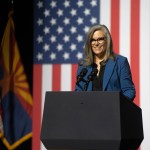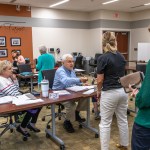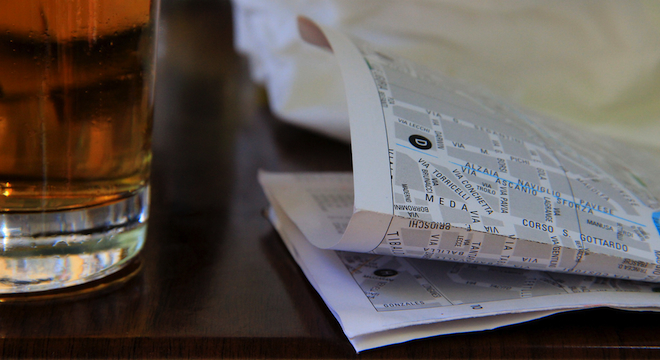Nevermind Apple’s maps misfire, the free, volunteer-made OpenStreetMap may end up reigning supreme anyway, as companies increasingly choose it for map data over Google. But as the project grows, it’s becoming harder and harder for its members to agree on what direction to go in next. Part 3 of a 3-part series. Read part 1 here and part 2 here.
Maps can help guide us through life, but they also shape how we see the world, for better or worse.
Take the classic example of the “Gall-Peters Projection,” created by German historian Arno Peters, based off the work of Scottish evangelical minister and astronomer John Gall, which seeks to represent area accurately — so that areas of the same size on the map appear so, which is not the case for other flat maps of spherical areas.
When Peters unveiled his map to the world in 1973, it caused a firestorm of controversy, as he claimed it was more accurate and fair to non-Western countries that the common map, the Mercator projection, which distorts area — increasing the size of objects the further away they are from the equator, with the result being the Greenland looks disproportionately huge to Africa, but does so in an effort to aid navigation by representing lines constant to compass directions.
The Gall-Peters projection looks quite different from a typical Mercator projection map, squishing countries near the poles vertically and stretching those near the equator.
Here’s an image of the Gall-Peters map from the Wikimedia Commons:

And here’s an image of the Mercator projection from the Wikimedia Commons:

The controversy was even featured in an episode of “The West Wing”:
OpenStreetMap, a free crowdsourced world map assembled by volunteers around the globe who now number over 800,000, also has its own issues when it comes to representing objects, as well as with the actual creation process of the map itself, at least according to some participants in the project mentioned during the State of the Map USA conference in Portland from October 13-14.
Mappy hour
On Saturday, following the first full day of talks, most of the attendees of the State of the Map USA conference walked a mile South to the Refuge, an event space rented out for the occasion and stocked with courtesy local brews and snacks.
There’s actual something of a tradition among OpenStreetMap members, lately American ones, of getting together at bars and other spirit-serving establishments in what they call “Mappy Hours,” booze-fueled updating sessions where enthusiasts edit map data.
But even these types of events are being called into question as the project matures.
“‘Mappy Hour’ loses a lot of meaning to those who don’t drink,” said Kate Chapman, founder of the OSM U.S. chapter, which launched in early 2010, and the founder/director of a related crisis-mapping project called Humanitarian OpenStreetMap Team (HOT), during one of her two presentations at the conference Saturday afternoon. For the record, Chapman, a trained geographer, does herself like to drink socially.
Chapman’s concern isn’t with Mappy Hours, though, so much as it is with the lack of efforts being made by OSM’s core members to reach out to a wider and more diverse group of participants.
“There’s a lack of diversity within the project,” Chapman pointed out to TPM on Sunday, an observation confirmed by the nearly four-to-one ratio of men to women at the State of the Map USA conference. “It’s mostly middle class white dudes. The other thing is that the main language of OSM is English. When you look at how it gets started in other countries, it’s usually when one or two people who speak English take the time to learn how to use the tools and then drag others into it.”
Chapman would know, as she now lives in Indonesia, where she helped jumpstart the OSM chapter there, training volunteer mapmakers who’ve now mapped some 1.5 million buildings.
And since she founded HOT in 2010, she’s been traveling to other countries, including Haiti in the aftermath of the 2010 earthquake, to help with the group’s mission to provide accurate, updated maps of areas hit by natural disasters for crisis responders.

“The reason I think the lack of diversity is a problem is we say we’re making a map of the world and anyone can do it,” Chapman said. “But we’re not there yet.”
Specifically, Chapman notes that when it comes to “tagging” or categorizing the type of places that appear on OpenStreetMap.
“You can map different types of sex clubs in insane detail,” Chapman told TPM in an interview, “But there’s not the case for women’s health centers, for example. Maps are an abstraction of reality, but who’s reality are we talking about?”
Another part of that, as Chapman points out, is due to the fact that even getting started as a new contributor to OSM isn’t exactly the most intuitive or user-friendly experience. Just mapping anything requires new cartographers to read through a bunch of Wiki pages and familiarize themselves with OSM’s two main software editors: JOSM and Potlach.
Chapman’s written a lengthy article on her own blog outlining how and why OSM’s interface should be simplified.
Chapman also believes that Foursquare and the myriad commercial map companies now flocking to use OSM’s data in the wake of Google’s decision to begin charging for its maps will end up helping to simplify and expand the appeal of the project beyond its predominantly white, male “Euro-centric” base, as Chapman puts it.
“After Foursquare started using OSM, people all around the world started mapping,” Chapman said, specifically citing the burgeoning OSM communities in Indonesia and Brazil as two examples.
Of course, Chapman’s not the only one noting how OSM’s currently complicated starting process is a barrier to entry, not dissuading new contributors, but commercial adopters as well.
Nikki Gunn Rodenbeck, founder of SoftCities, a startup that makes personalized map-patterned blankets and napkins out of OSM data, said during her talk at the conference that the OSM beginner’s guide is “so scary,” and pointed to the Twitter for Businesses page as a counter-example of what a more inviting, useful interface would look like.
The OpenStreetMap Foundation’s Board Members acknowledge that diversity is an ongoing issue with the project.
“We don’t have figures for the number of women contributors to OSM but I don’t think there’s any doubt that it’s fairly small,” Fairhurst told TPM. “As the editing tools become easier to use and more varied, I’m hopeful we can go some way to rectifying that.”
Where we’re going, we don’t need roads
Simplicity and ease-of-use are the driving forces behind D.C-based startup MapBox’s $575,000 quest to improve OSM.
“This is my first state of the Map, and we’re about to do some major work,” said MapBox CEO Eric Gundersen during his talk Saturday.
MapBox builds cloud-based maps and mapmaking software off of OpenStreetMap data and was one of the 16 private sponsors of the State of the Map Conference, with MapBox operations manager Bonnie Bogle coordinating many of the key details.
In late September, MapBox was awarded a $575,000 grant from the Knight Foundation specifically to allow MapBox to focus all of its efforts over the next few months on “launching tools that make it easier for communities to contribute.”
The company laid out some of its initial plans at the State of the Map conference, including proposals to have MapBox software engineers combine bits of information and hide and emphasize others on the OSM map view to make actually navigating the map a more pleasant and efficient experience.
But some of the OSM community members in the audience expressed misgivings about the pace of change and MapBox’s paid involvement to focus solely on OSM for the next few months, after which time, the company’s involvement could be scaled down, leaving volunteer cartographers back where they started.
Gundersen and his team aren’t much fazed by those concerns though. They’re conscious of them, to be sure, they just think that their work on OSM will prove to members MapBox’s long-term commitment and benefit to the project.
“We really respect those concerns,” Gundersen told TPM. “Those are real…but every major issue that’s come up here has been channeled into next actions. It shows the OpenStreetMap Foundation is effective and the U.S. chapter is effective. The strength is not in having agreement all the time, but in having systems to address disagreement.”
MapBox has another ace up its sleeve, though: Its own data team leader Alex Barth was voted onto the OSM U.S. chapter Board during the conference.

“The best of our year has yet to play out,” Gundersen told TPM about the company’s next steps. “We’re focused on the biggest plays for the end of the year. Stuff’s about to get really interesting. You’ll see.”
This was the third and final installment of “The New Cartographers” series on OpenStreetMap. Read part 1 here and part 2 here.
Correction: This article originally incorrectly referred to maps of Earth as depicting a “cylindrical area” on a flat surface, when in fact, the Earth is of course spherical and thus maps of the world attempt to depict that area on a flat surface. The error has since been corrected in copy and we regret it.









